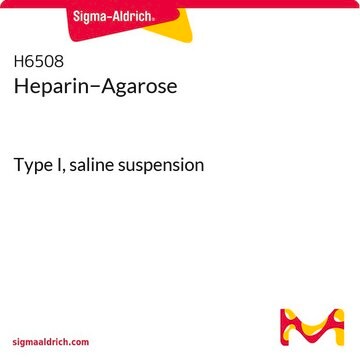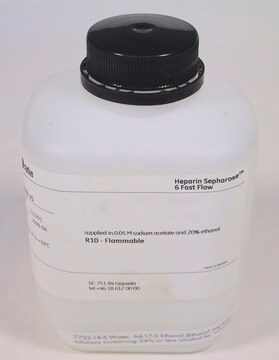H0402
Heparin−Agarose
(1:1 suspension in a 20% ethanol solution)
About This Item
Empfohlene Produkte
Biologische Quelle
heparin from Porcine intestinal mucosa
Form
(1:1 suspension in a 20% ethanol solution)
Matrix
4% beaded agarose
Matrixaktivierung
epichlorohydrin
Matrixanbindung
terminal aldehyde by reductive amination to amine linker
Matrix-Spacer
7 atoms
Kapazität
≥0.5 mg/mL binding capacity (thrombin)
Lagertemp.
2-8°C
Suchen Sie nach ähnlichen Produkten? Aufrufen Leitfaden zum Produktvergleich
Anwendung
Physikalische Form
Angaben zur Herstellung
Signalwort
Warning
H-Sätze
Gefahreneinstufungen
Flam. Liq. 3
Lagerklassenschlüssel
3 - Flammable liquids
WGK
WGK 3
Flammpunkt (°F)
104.0 °F - closed cup
Flammpunkt (°C)
40 °C - closed cup
Analysenzertifikate (COA)
Suchen Sie nach Analysenzertifikate (COA), indem Sie die Lot-/Chargennummer des Produkts eingeben. Lot- und Chargennummern sind auf dem Produktetikett hinter den Wörtern ‘Lot’ oder ‘Batch’ (Lot oder Charge) zu finden.
Besitzen Sie dieses Produkt bereits?
In der Dokumentenbibliothek finden Sie die Dokumentation zu den Produkten, die Sie kürzlich erworben haben.
Kunden haben sich ebenfalls angesehen
Unser Team von Wissenschaftlern verfügt über Erfahrung in allen Forschungsbereichen einschließlich Life Science, Materialwissenschaften, chemischer Synthese, Chromatographie, Analytik und vielen mehr..
Setzen Sie sich mit dem technischen Dienst in Verbindung.










